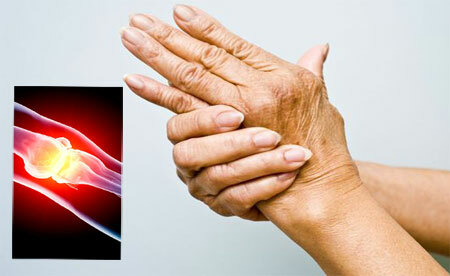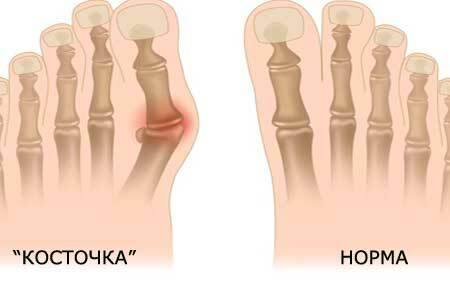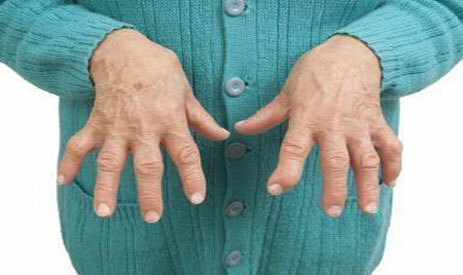In the inflammatory process in the joint, doctors talk about the development of arthritis, but if the pathological process is detected simultaneously in several joints, then we are talking about polyarthritis.
Contents
- 1 Polyarthritis - what is it?
- 2 Signs and forms of polyarthritis
- 3 Symptoms of polyarthritis
- 4 Treatment of polyarthritis, preparations
- 4.1 Complications of polyarthritis
- 4.2 Prevention of polyarthritis
Polyarthritis - what is it?

Polyarthritis is a disease characterized by the development of the inflammatory process simultaneously in several( most often symmetrical) joints. The disease progresses rapidly, it breaks the normal way of life of a person and can lead to disability.
Inflammatory process in joints can develop for numerous reasons, the most frequent of which are:
- Postponed infectious diseases( eg, angina), as a result of which an infectious agent with blood flow enters the joint and provokes the development of the pathological process in it;
- Severe joint injury;
- Subcooling;
- Autoimmune diseases;
- Genetic predisposition;
- The presence of foci of chronic infection in the body;
- Allergic diseases;
- Infringement of blood supply in joints.
To find out the cause and form of the disease is important for determining the effective tactics of treating polyarthritis, the symptoms serve as an important diagnostic criterion.
Symptoms and forms of polyarthritis
Clinical polyarthritis occurs almost the same regardless of the causes of the onset, however, depending on the factors that influence the development of the inflammatory process in the joints, the following forms of the disease are distinguished:
- Rheumatoid polyarthritis - develops as a result of infectious diseases, unsuccessful vaccination, against the background of which the thymus gland begins to produce antibodies that destroy their own cells, in particular, the tissues of the joint;
- Psoriatic polyarthritis - the disease develops against a background of prolonged course and progression of psoriasis;
- Infectious polyarthritis - occurs against the background of the transmitted infectious and inflammatory diseases, as a complication;
- Crystalline polyarthritis( nodular) - develops as a result of disturbances in metabolic processes in the body, characterized by the deposition and accumulation of crystals of mineral salts in the tissues of the joint;
- Bechterew's disease - this type of polyarthritis affects mainly the joints of the spinal column, as a result of which a complete disability of the patient gradually develops;
- Reactive polyarthritis - occurs against the background of chlamydia infection as a complication of infection.
Symptoms of polyarthritis

Symptoms of polyarthritis, photos
Symptoms of inflammation in the joints in any form of the disease are almost identical clinical symptoms of polyarthritis:
- Joint pain, aggravated by stress, movement;
- Swelling and redness of the skin over the inflamed and affected joint;
- Local hyperthermia, sometimes elevated body temperature to subfebrile indicators;
- Stiffness of movements, which is most pronounced after a sleep in the morning - is due to the accumulation over the night in the cavity of the affected joint pathological fluid that limits the full motion;
- Chilliness of limbs, numbness;
- Gradual deformity of the limbs( with polyarthritis of the fingers and polyarthritis of the legs)
In crystalline polyarthritis, as a result of the accumulation and deposition of mineral salts, the limbs of the patient become severely limited, the nodules are clearly visible under the skin, which is why this form is also called nodular polyarthritis.
If such clinical symptoms of polyarthritis appear, the patient should consult a doctor as soon as possible for a detailed examination.
To diagnose for an experienced specialist is not particularly difficult - to determine the form of the disease will help the patient's medical history, signs and symptoms of polyarthritis and a detailed examination, including:
- Revmoprobes;
- Blood tests - general and biochemistry;
- Radiographic study.
Treatment of polyarthritis, preparations

For each form of joint polyarthritis treatment can be different depending on the symptoms:
- Non-steroidal anti-inflammatory drugs - quickly relieve swelling of the skin over the affected joint, reduce pain, normalize temperature, increase the amplitude of movements;
- Glucocorticosteroids - are prescribed for severe disease, sometimes in the form of injections directly into the cavity of the inflamed joint. Preparations of this group quickly remove inflammation, pain, swelling, normalize the motor ability of the joint;
- Immunomodulators - increase immunity and stimulate tissue regeneration processes;
- Physiotherapeutic procedures outside the period of exacerbation - can significantly improve the quality of life of the patient, increase the mobility of the affected joints.
In the treatment of crystalline polyarthritis, the patient is prescribed additional drugs that normalize metabolic processes in the body, as well as therapeutic nutrition.
The diet is to limit consumption of baking, chocolate, spices, spicy foods, fatty meat, subproducts, coffee, alcohol. In the diet should include more fresh seasonal vegetables and fruits, fish, sour-milk products.
How to treat polyarthritis can be effectively explained only by a specialist, after comprehensive diagnosis, determining the causes and form of the disease. Remember that no folk methods will relieve you of the problem, but will only lead to the progression of pathology and the development of complications.
Complications of polyarthritis
Most complications develop with rheumatoid form of polyarthritis and are caused by involvement of the muscles attached to the affected joints in the pathological process. As a result of the spread of pathology to the fibers of the muscle tissue, the functioning of the adjacent internal organs is also disrupted, resulting in the following complications of the polyarthritis:
- Heart and vessel diseases - inflammation of the heart membranes, impaired blood supply to the heart muscle and ischemia;
- Muscle atrophy, decreased mobility and self-service capabilities;
- Loss of appetite and discomfort in the work of the digestive tract, in the background of which the patient loses weight and weakens;
- Deformation of limbs;
- Loss of sensitivity at the fingertips, tingling sensation, numbness;
- Small hemorrhages under the skin;
- Increased sweating;
- Disturbance of metabolic processes, osteoporosis, propensity to fractures.
Prevention of polyarthritis
As the cause of the development of polyarthritis can become many factors, in order to prevent inflammation in the joints, the patient should try not to let their influence on the body, namely:
- A full and balanced diet;
- Maintain an active and mobile way of life;
- Timely treatment of infectious diseases, prevent their transition to a chronic form;
- Avoid injury and joint damage;
- Do not allow the body to subcool;
- Do not subject the joints to excessive loads.
Persons with a hereditary predisposition to the development of polyarthritis should, after 45 years of age, regularly, for prevention, to see a doctor and take blood tests.



